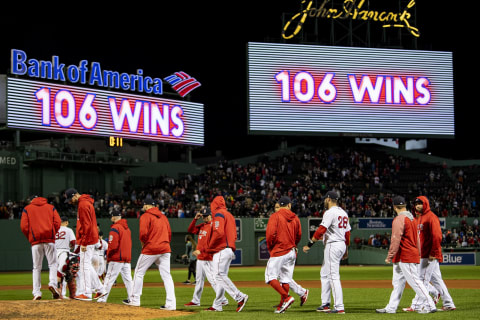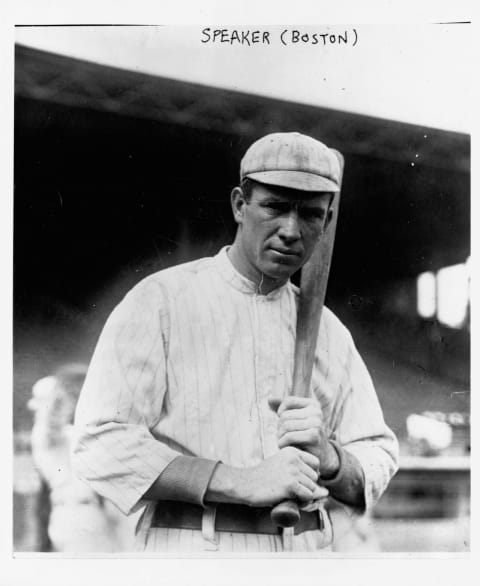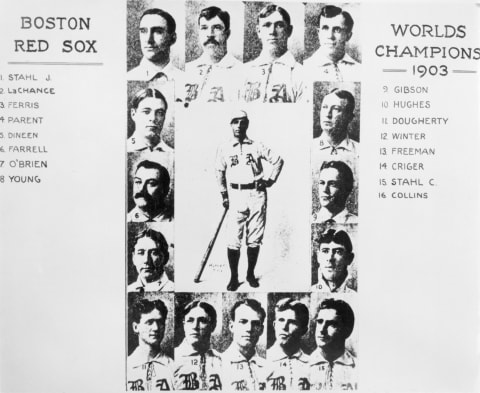Boston Red Sox: Are the 2018 Red Sox the best team in franchise history?


The 2018 Boston Red Sox have the most wins in franchise history, but are they the best Red Sox team ever?
With a 6-2 victory over the Baltimore Orioles on Monday, the 2018 Boston Red Sox won their 106th game of the season. This gave them the most wins by any team since the 2001 Seattle Mariners tied the MLB record with 116 wins. Since the Mariners’ record-tying season, the most wins by any team was the 105 victories put up by the 2004 St. Louis Cardinals. If the 2018 Red Sox can win four of their last five games, they’ll be one of only seven teams in baseball history to win 110 games in a season.
The Red Sox’ 106th victory this season also moved them to the top of the single-season wins list in franchise history. The previous leader was the 1912 Red Sox, who went 105-47-2 in a 154-game season. The best position player on that team was Tris Speaker, a fleet-footed centerfielder who won AL MVP honors. They also had ace starting pitcher Smoky Joe Wood, who went 34-5 with a 1.91 ERA in 344 innings pitched.
This year’s Red Sox team has its own AL MVP candidate. Mookie Betts is battling Mike Trout for the AL lead in multiple versions of Wins Above Replacement (WAR). He leads Trout 9.9 to 9.4 in Fangraphs WAR, with Jose Ramirez in third place, at 8.0. He also leads Trout 10.7 to 9.9 in Baseball-Reference WAR, with Matt Chapman in third place, at 8.1. Baseball Prospectus has them flipped, with Trout at 9.0 and Betts at 8.8. Alex Bregman is third, at 7.7.
A more traditional voter might be swayed by J.D. Martinez, who has 41 homers and leads the AL in RBI. Those two categories are about the only things he’s done better than Betts, though, as Mookie leads him in batting average, on-base percentage, slugging percentage, runs scored, stolen bases, and is much better on defense. It would be a shame if voters shifted MVP votes from Betts to Martinez.
Other top hitters on the Red Sox include shortstop Xander Bogaerts (21 HR, 96 RBI, .286/.357/.509) and left fielder Andrew Benintendi (100 R, 21 SB, .285/.363/.460). Center fielder Jackie Bradley, Jr. has been a below average hitter, but his defense has made him an above average player overall. Since coming over in a trade with the Blue Jays in late June, Steve Pearce has hit .283/.400/.504 with the Sox. Overall, the Red Sox have the third-best collection of position players in the AL, per Fangraphs WAR.
Chris Sale has been the Red Sox best pitcher. He’s pitched less than half the innings that Smoky Joe Wood pitched in 1912, but his 2.00 ERA is comparable. If Sale had enough innings to qualify for the ERA title—he’s 8.7 innings short—he would have the highest single-season strikeout rate by a starting pitcher in MLB history. He’s struck out 38.5 percent of the batters he’s faced this year. Another Boston Red Sox pitcher, Pedro Martinez in 1999, has the record, at 37.5 percent.
Along with Sale, the Red Sox rotation has David Price (15-7, 3.53 ERA), Rick Porcello (17-7, 4.33 ERA) and Eduardo Rodriguez (12-4, 3.73 ERA). Red Sox starting pitchers are sixth in the AL in WAR, per Fangraphs. The bullpen, led by Craig Kimbrel and his 2.21 ERA, ranks eighth of the 15 American League teams.
How do the 2018 Red Sox compare to the best Red Sox teams in franchise history? They have the most wins, but have also played more games than the other top Red Sox teams. Their .675 winning percentage is tied for second with the 1946 squad, behind the 1912 Red Sox team that had a .691 winning percentage. The 1912 team also had the best run-differential in franchise history. We know what the 2018 team looks like. Now let’s take a look at the other top teams fielded by the Red Sox.

Speaker and Wood, these guys were good
1912 Red Sox, 105-47-2, .691, won World Series
Pythagorean W-L: .669, +255 run-differential
Top Hitter: Tris Speaker (9.2 bWAR)
Top Pitcher: Smoky Joe Wood (10.2 bWAR)
Position Players AL rank: 2ndPitchers AL rank: 1st
The previous Red Sox team with the most wins in a season played in an eight-team American League back when baseball only had 16 teams. The won the AL by 14 games over the Washington Senators, then won the World Series over the New York Giants. They scored the most runs and allowed the fewest, giving them by far the best run-differential in the AL. They were a very impressive 57-20 at home (.740). This year’s Red Sox are 55-21 at home (.724).
Home in those day was Fenway Park, just like today, but this was back when Fenway was a brand new stadium. It opened on April 20, 1912, just five days after the sinking of the Titanic. The ballpark was fit into the Fenway-Kenmore neighborhood, which resulted in its quirky features, like the famous Green Monster in left field.
The 1912 Boston Red Sox got off to a good start, but they couldn’t get past the Chicago White Sox as the season moved into June. An impressive 14-1 stretch from June 8 to June 24 put them in first place, a spot they would not relinquish for the rest of the season. They had another 14-1 stretch from late August to early September.
As mentioned earlier, Tris Speaker was the team’s best position player. He hit .383/.464/.567, with 136 runs and 52 steals. He also led the team in home runs, with 10. Larry Gardner (.315/.383/.449, 88 R, 18 triples, 25 steals) provided speed and a great on-base percentage, as did Heinie Wagner (.358 OBP, 21 SB).
While Smoky Joe Wood was going 34-5 with a 1.91 ERA, Buck O’Brien (20-13, 2.58 ERA) and Hugh Bedient (20-9, 2.92 ERA) each won 20 games as part of a Red Sox rotation that featured five pitchers with at least 13 wins. Four of the five pitchers in the starting rotation had 17 or more complete games. It was a very different time.
The 2018 Red Sox may have the most wins in a season in franchise history, but this 1912 team has the best winning percentage and best run-differential of any Red Sox team. This is the team to beat in a contest of best Red Sox teams ever. The 2018 Red Sox are close.

Teddy Ballgame and the boys
1946 Red Sox, 104-50-2, .675, lost World Series
Pythagorean W-L: .629, +198 run-differential
Top Hitter: Ted Williams (10.9 bWAR)
Top Pitcher: Tex Hughson (5.9 bWAR)
Position Players AL rank: 1st
Pitchers AL rank: 2nd
After winning the World Series three times in four years from 1915 to 1918, the Boston Red Sox went more than 25 years before making it back to the World Series. They finished in the bottom half of the standings regularly throughout the 1920s and into the late 1930s. Ted Williams arrived in Boston in 1939 and the team started to win again, finishing in 2nd place in 1941 and 1942.
With Williams serving in World War II from 1943 to 1945, the Red Sox struggled, but his return in 1946 changed everything. Suddenly, the Red Sox were a dominant team that won 104 games and cruised to the AL pennant by 12 games. They had the league’s best offense and second-best pitching. Unfortunately, they lost the World Series to the St. Louis Cardinals in seven games.
Williams, of course, was the best player on the 1946 Red Sox. Before he served in World War II, he was coming off two straight seasons in which he led the AL in batting average, on-base percentage, and slugging percentage, a sabermetric Triple Crown. After missing three seasons, he came back and led the league in on-base percentage and slugging percentage four straight seasons.
In addition to leading the league in on-base percentage and slugging percentage in 1946, Williams also led the AL in runs scored, walks and total bases. His performance earned him his first AL MVP Award. He also had four second-place finishes in MVP Voting (he was kind of the Mike Trout of his day when it came to MVP voting).
The Red Sox had other great players that year, including shortstop Johnny Pesky (115 R, 208 H, .335/.401/.427), second baseman Bobby Doerr (95 R, 116 RBI, .271/.346/.453) and center fielder Dom DiMaggio (85 R, .393 OBP). The Red Sox scored 792 runs that year, 88 more than the next-closest team, the Detroit Tigers.
On the bump, Dave Ferriss had the most wins on the team, going 25-6, but his 3.25 ERA was a half-run higher than Tex Hughson, who was 20-11. Third starter Mickey Harris was 17-9 with a 3.64 ERA and Joe Dobson was 13-7 with a 3.24 ERA. The save statistic had yet to be invented, but a retroactive tally of saves gave nine to relief pitcher Bob Klinger.
The 1946 Boston Red Sox had the third-most wins in franchise history. Their .675 winning percentage is tied with the 2018 Red Sox for the second-best mark ever, but their 198 run-differential is seventh-most among Red Sox squads.

When the Babe was just a babe
1915 Red Sox, 101-50-4, .669, won World Series
Pythagorean W-L: .631, +170 run-differential
Top Hitter: Tris Speaker (7.1 bWAR)
Top Pitcher: Ernie Shore (5.4 bWAR)
Position Players AL rank: 3rd
Pitchers AL rank: 4th
This Red Sox team has the fourth-most wins in franchise history and the fifth-best Pythagorean win-loss record, although their run-differential doesn’t rank in the top five. They got off to a slow start, going 14-15 in their first 29 games. As the season moved into late May, they were in fourth place, 6.5 games out of first.
Starting with the second game of a double-header on May 29, the Red Sox went 15-3 over the next few weeks. A 22-10 July helped them take over first place in the American League and a 21-6 August kept them at the top of the standings, but Ty Cobb’s Detroit Tigers were hanging close. The Red Sox went 20-7 in September, but still couldn’t shake Detroit. Ultimately, they finished the season in early October with a record of 101-50-4 while the Tigers were 100-54, 2.5 games out.
Their top hitter on the 1915 Red Sox was still Tris Speaker, just like in 1912. Speaker hit .322/.416/.411, with 108 runs scored and 29 steals. He was part of a terrific outfield that included Harry Hooper and Duffy Lewis, which was considered the best outfield in baseball. Unfortunately for Red Sox fans of the time, this would be Speaker’s last season with the team. When he refused to take a 50 percent pay cut before the 1916 season, the Red Sox traded him to Cleveland.
In addition to their “million dollar outfield”, the Red Sox had solid production from first baseman Dick Hoblitzell and third baseman Larry Gardner. The key to the team, though, was their strong pitching staff. Ernie Shore (19-8, 1.64 ERA, 247 IP) and Smoky Joe Wood (15-5, 1.49 ERA, 157.3 IP) were their top starters, with Rube Foster (19-8, 2.11 ERA, 255.3 IP) and Dutch Leonard (15-7, 2.36 ERA, 183.3 IP) right there with them.
The youngest member of the starting rotation was 20-year-old Babe Ruth, who was in his second major league season. Ruth pitched 217.7 innings with a 2.44 ERA in 1915. At the plate, he hit .315/.375/.576, with four home runs in 103 plate appearances. No other Red Sox player hit more than two homers and the three players who hit that many did so in 450 or more plate appearances.
Ruth would continue mainly as a pitcher over the next three years before transitioning to a two-way player in 1918 and 1919. In December of 1919, the Red Sox infamously sold Ruth to the Yankees. Ruth crushed an MLB-record 54 dingers in 1920 and dominated baseball for the next decade. The Red Sox, meanwhile, went into a tailspin that lasted into the 1940s.

The Cyclone
1903 Americans, 91-47-3, .659, won World Series
Pythagorean W-L: .651, +204 run-differential
Top Hitter: Freddy Parent (6.4 bWAR)
Top Pitcher: Cy Young (7.1 bWAR)
Position Players AL rank: 1st
Pitchers AL rank: 3rd
Before they were the Red Sox, the Boston team in the American League was called the Americans. This 1903 team was their first great team. They have the fifth-best winning percentage of any Red Sox squad and second-best Pythagorean win-loss record.
The 1903 Americans started slowly, going 4-6 in April, but a 15-9 May pushed them to the top of the standings heading into June. They battled with the Philadelphia A’s and Cleveland Naps for most of June before Cleveland fell off a bit. By the end of July, it was the Americans and A’s at the top of the AL. The Americans went 37-16 over the final two months of the season and ended up winning the AL pennant by 14 games.
This was just the third year in existence for the American League. When the National League contracted from twelve teams to eight in 1900, the president of the minor league Western League, Ban Johnson, swooped in and created the American League as a major league rival to the NL.
The leagues didn’t get along well in 1901 and 1902, but tensions eased in the winter before the 1903 season. When the Boston Americans and Pittsburgh Pirates won their respective leagues in 1903, they faced each other in what would become known as the World Series. The Americans won the best-of-nine series, fives games to three.
The left side of the infield, shortstop Freddy Parent and third baseman Jimmy Collins, led the Americans on offense, with outfielders Patsy Dougherty and Buck Freeman also among the teams’ best hitters. Parent, Collins and Dougherty combined for 82 steals among them and Dougherty led the team in runs scored, with 107. Freeman provided the pop, hitting 13 home runs. Pitcher Cy Young hit .321/.340/.431 in 146 plate appearances.
Of course, it was on the mound where Young truly shined. He was 28-9 with a 2.08 ERA in 341.7 innings. It was the third straight year he led the AL in wins and the second straight season leading the league in innings pitched. Young was 36 years old at the end of the 1903 season and had 379 career wins. He would go on to win another 132 games over the next eight seasons.
The Americans had two other 20-game winners on this team. Bill Dinneen was 21-13 with a 2.26 ERA in 299 innings and Tom Hughes was 20-7 with a 2.57 ERA in 244.7 innings. The team only used six pitchers the entire season and one of those started just a single game.
Next. Each AL playoff team with RISP. dark
That’s our countdown of the best Boston Red Sox teams in franchise history. Where do you think the 2018 squad ranks among these teams? Comment below!